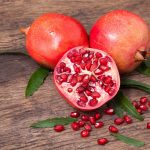 The only edible part of the pomegranate is the red globule surrounding each of the seemingly innumerable seeds contained by the pulp and rind of the fruit. These seeds give the fruit its name, for pomegranate means apple filled with seeds, a name bestowed upon it by the ancient Romans, who originally called it, in Latin, malum granatum. Gra.nn.lum developed from the Latin granum, meaning seed, which is also the source of grain, of gravy (a sauce spiced with grains of pepper), and of granite (a rock with a grainy texture). Malum developed from the Greek melon, meaning apple, which is of course also the source of melon as in watermelon. Had the Romans persisted in calling the pomegranate a malum granatum we might today know it as a malumgranate; instead, however, those fickle ancients changed the name to pomum granatum, perhaps because the malum that meant apple sounded like the unrelated malum, meaning evil. The Latin pomum—like the word malum before it—also meant apple, and in fact it developed into pomme, the French word for apple. Likewise, pomum granatum developed into the French pome granate, which became the English pomegranate in the early fourteenth century. In French, however, the original pome granate evolved very differently over the succeeding centuries: the pomme was dropped, and the first vowel and last consonant in granate shifted, resulting in a new French name for pomegranate, grenade. The resemblance of the pomegranate to seventeenth-century handheld explosives led to the name grenade being bestowed upon the munition. The French name of the fruit is also the source of grenadine, a syrup made from pomegranates, and even, thanks to a reversal of letters in the word, of garnet, a precious stone coloured red like the pomegranate.
The only edible part of the pomegranate is the red globule surrounding each of the seemingly innumerable seeds contained by the pulp and rind of the fruit. These seeds give the fruit its name, for pomegranate means apple filled with seeds, a name bestowed upon it by the ancient Romans, who originally called it, in Latin, malum granatum. Gra.nn.lum developed from the Latin granum, meaning seed, which is also the source of grain, of gravy (a sauce spiced with grains of pepper), and of granite (a rock with a grainy texture). Malum developed from the Greek melon, meaning apple, which is of course also the source of melon as in watermelon. Had the Romans persisted in calling the pomegranate a malum granatum we might today know it as a malumgranate; instead, however, those fickle ancients changed the name to pomum granatum, perhaps because the malum that meant apple sounded like the unrelated malum, meaning evil. The Latin pomum—like the word malum before it—also meant apple, and in fact it developed into pomme, the French word for apple. Likewise, pomum granatum developed into the French pome granate, which became the English pomegranate in the early fourteenth century. In French, however, the original pome granate evolved very differently over the succeeding centuries: the pomme was dropped, and the first vowel and last consonant in granate shifted, resulting in a new French name for pomegranate, grenade. The resemblance of the pomegranate to seventeenth-century handheld explosives led to the name grenade being bestowed upon the munition. The French name of the fruit is also the source of grenadine, a syrup made from pomegranates, and even, thanks to a reversal of letters in the word, of garnet, a precious stone coloured red like the pomegranate.
A thick-skinned, red tree fruit that has edible seeds.
This term is used to describe a fruit that is native to Africa and Asia, and is known for its brilliant red, hard rind and tart, translucent scarlet pulp, in which many seeds are embedded. The fruit is roughly the size of a large apple, and the seeds, which are covered with firm, juicy pulp, are a popular ingredient in fruit salads and other dishes. With its distinctive color and bold, tangy flavor, this fruit is a favorite among foodies and fruit lovers alike, and is enjoyed in a wide range of cuisines around the world. Whether eaten on its own or used to add a burst of flavor to sweet and savory dishes alike, this unique and delicious fruit is sure to please.
Within the realms of Southern Europe, Eastern countries, and South America, we discover a remarkable fruit that graces our senses the pomegranate. This exquisite fruit, reminiscent in size to an orange, boasts a captivating yellowish-red hue and conceals within its core a profusion of pulpy red grains. Delightfully, the pomegranate yields a luscious juice when gently squeezed, which, once strained to remove the seeds, finds its way into refreshing beverages and serves as a delightful flavoring for icy confections. In the lands of Persia, the fruit undergoes a transformation into a cherished wine, while in Mexico, a captivating liqueur known as Aguardiente emerges, crafted with the essence of pomegranates.
